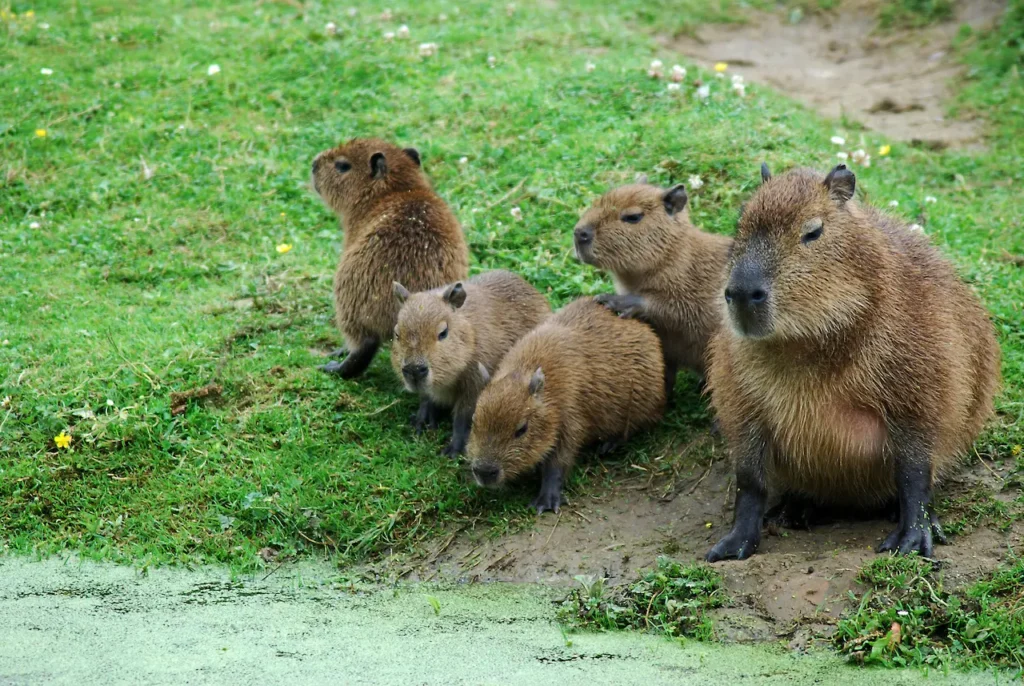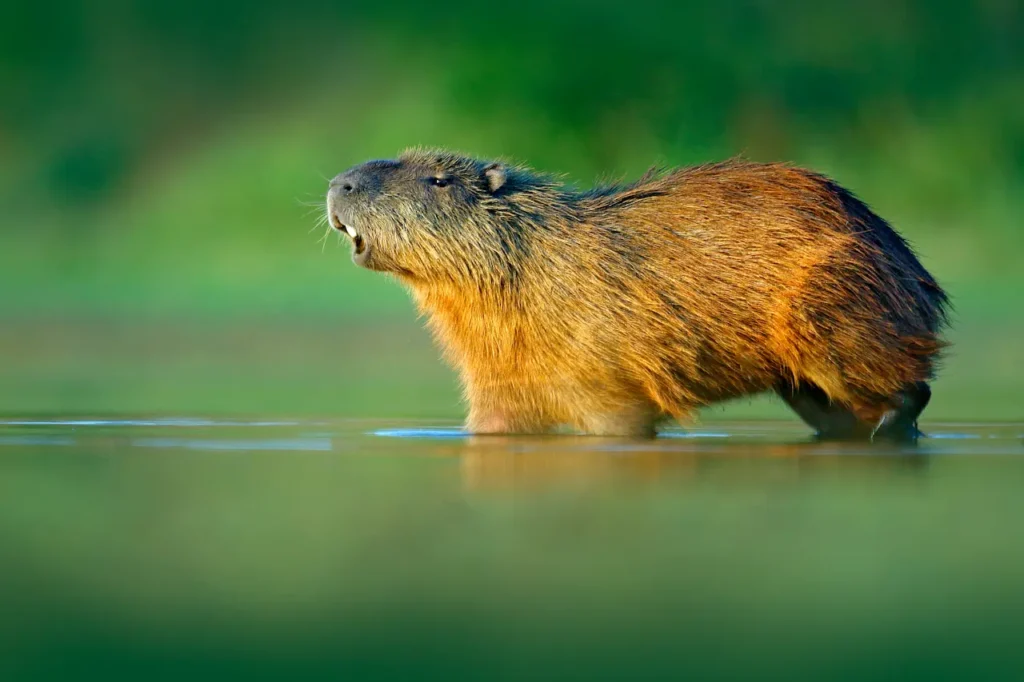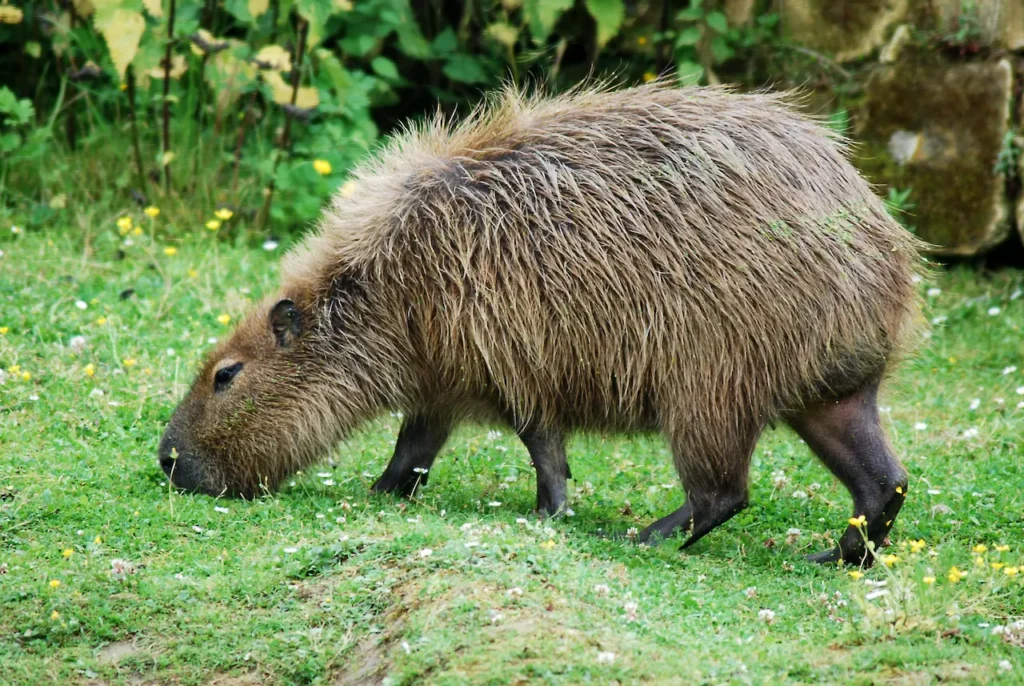What Eats A Capybara?
Categories
- Accipitridae (1)
- Acrididae (1)
- Algae (2)
- Alligatoridae (1)
- Amoebidae (1)
- Amphibians (3)
- Anatidae (1)
- Anguillidae (1)
- Arachnids (2)
- Bears (2)
- Big Cats (3)
- Birds (13)
- Bovidae (5)
- Bufonidae (1)
- Camelids (1)
- Cameras (1)
- Canines (13)
- Caridea (1)
- Carnivora (10)
- Castoridae (1)
- Cats (5)
- Cebidae (1)
- Cephalopod (1)
- Cervidae (2)
- Cetacean (1)
- Chondrichthyes (1)
- Crocodilia (2)
- Crustaceans (4)
- Culicidae (1)
- Cyaneidae (1)
- Dasypodidae (1)
- Dasyurids (1)
- Deer (1)
- Delphinidae (1)
- Desktop (1)
- Didelphidae (1)
- Dinosaurs (1)
- Dogs (13)
- Dolphins (2)
- Echinoderms (1)
- Education (10)
- Elephantidae (1)
- Equine (1)
- Erethizontidae (1)
- Erinaceidae (1)
- Farming (1)
- Felidae (5)
- Fish (5)
- Food Chain (31)
- Food Web (2)
- Formicidae (1)
- Frugivore (1)
- Gaming (1)
- Gastropods (1)
- Giraffids (1)
- Great Apes (2)
- Health Conditions (3)
- Herbivore (4)
- Hi-Fi (1)
- Hippopotamidae (1)
- Hominidae (1)
- Insects (10)
- Invertebrates (2)
- Keyboards (1)
- Laptops (1)
- Leporidae (1)
- Mammals (23)
- Marsupials (4)
- Mephitidae (1)
- Microchiroptera (1)
- Mollusks (2)
- Mongoose (1)
- Muridae (1)
- Nocturnal Animals (1)
- Odobenidae (1)
- Omnivore (2)
- Phasianidae (1)
- Phocidae (1)
- Plankton (1)
- Plants (2)
- Primate (1)
- Ranidae (1)
- Reptiles (7)
- Rhinocerotidae (1)
- Rodents (5)
- Salamandridae (1)
- Scarabaeidae (1)
- Sciuridae (2)
- Sharks (1)
- Shellfish (1)
- Sound (1)
- Spheniscidae (1)
- Suidae (1)
- Superfamily Papilionoidea (1)
- Theraphosidae (1)
- What Eats (5)
Introduction
The capybara is regarded as the largest rodent in the world today. It is a sociable, water-loving animal native to South America. Capybaras are social animals that live in groups and mostly around water bodies. There are different environmental niches, such as tropical rainforests and grasslands, and capybaras have been able to live in all of them. Their availability of food and natural enemies varies greatly in the environment they are in.
In this article, the focus will be on the discussion of internal capybara predators as well as on the external aspects of interactions of these animals with the vegetable kingdom. The reasons why other animals feed on capybaras and why capybaras eat what they do will be made clearer.
What Eats A Capybara?
Capybaras face predation from numerous aquatic and terrestrial carnivores in South America. Their predators come from both land mammal and land reptile species. Being a bulky rodent, there are not so many capybara predators after it has reached adolescence. However, the younger ones have been known to be somewhat sensitive and, therefore, present today, one can be taken out by the following animals:
Jaguars
The jaguar is one of South America’s largest cats and the most famous predator of the capybara. These large members of the cat family are good bullies and can kill both adult and juvenile capybaras. The location of the ambush is usually the thick vegetation along rivers and water holes where jaguars hide and strike at capybaras.
They will also reach out from the water and grab fish and turtles so that they can directly compete with the capybara. Very large concentrations of danger emanate from jaguars that stalk their prey and have crushing-strength jaws. Twenty-five large adult cats are included and weigh over 100 kg. Females with more than two times higher levels are the bite of animals suckers.
Which, in turn, increases the chance of rapid death for the capybara since there is no animal underneath. Capybaras and their predators are both most active at the hours of twilight, making dusk and dawn the feeding times for the jaguars. Their marbled coats enable the jaguars to remain hidden in the forests and launch unexpected attacks. They are also fast and efficient hunters in water and will sometimes hunt for capybaras in the water. A few capybaras have been found in the dietary prey of jaguars.
Caimans
Caimans, like alligators, are a sub-group of crocodilians that are common in Central and South America. They, just like the jaguar, present as an ambush threat to the capybara, especially when standing in the rivers and swamps. The most formidable threat to capybaras comes from the Yacare caiman, which can exceed 2 meters in length.
Caimans have powerful jaws and move at a very fast speed, so they can capture capybaras both on the ground and in water. Caimans are known to float with only their eyes and nostrils visible above the water for some time until the prey gets close. Upon the approach of a capybara, they spring out of the water with a force of 3,000 pounds per inch or more. These teeth are more conical in shape and serve to capture a struggling fish.
With their scissors-like appendages, the caiman will snap the neck or leg of the capybara, thrust the victim below in water, and keep it there until death ensues. Younger and smaller caimans are active on juvenile capybaras, but the large adult ones can hunt and kill fully-grown ones. Very few numbers of capybaras are available to the caiman, and even fewer numbers are eaten, but those that are available are a source of food and calories for these hunters.
Anacondas
The green anaconda is a massive, non-venomous snake found in tropical South America. They are adept swimmers that can strike at capybaras in the water and on land. Anacondas are constrictors, coiling their heavy bodies around prey and squeezing tighter each time the animal exhales until it suffocates.
These snakes have been known to consume capybaras as well as other large mammals like deer and peccaries. Only very large anacondas can consume an adult capybara. An anaconda will wait patiently, half-submerged, for a capybara to approach the water’s edge. They move deceptively fast in the water, striking before the capybara realizes what is happening.
The snake quickly wraps its coils around the capybara, constricting tighter each time it breathes out. Their muscular bodies exert tremendous pressure, restricting blood flow and eventually suffocating the capybara within minutes. A very large female anaconda may attempt to consume a mature capybara. They can unhinge their jaws and slowly swallow the capybara whole over the course of several hours.
Pumas
Also referred to as cougars or mountain lions, pumas live in a large geographical area in southern and northern America, hunting for medium to large mammals. They are stealthy stalk and ambush predators whinging after capybaras until they become more successful, with hungry animals usually being low, such as other easier targets.
Pumas use their claws to hold the capybaras and wait till they are in a position to deliver a deadly jaw, neck, or head bite to the prey. Capybaras located in solitary habitats, which are the favourite of adult-focusing pumas, are the most severely endangered, although assaults are rare. In ambush hunting, a puma sneaks towards the prey, covering itself against the sun and behind plants until the distance is reduced to a striking margin. As close as the strike distance, a puma bursts from the bushes and runs after the capybara, who starts to make a getaway.
Pumas are capable of sprinting up to 50 mph for short distances, which is fast enough to pursue a capybara that is too fast. They will then jump on the capybara, grasping the spine of the neck and using their mouths to crush it. An adult puma can carry and hide a capybara that is three times regular squirrel size in a tree behind the safe branches. Although they do not frequently prey on capybaras, pumas help in controlling the number of capybaras in the same habitation areas as them.

Group of Capybara
Eagles
The harpy eagle is the largest and most powerful raptor in South America. These huge birds of prey hunt monkeys, sloths, and other tree-dwelling mammals. If given the opportunity, they will also attack capybaras. The harpy eagle kills with its massive rear talons, able to exert 500 psi of pressure. Its huge claws can crush a capybara’s skull and spine, delivering an instantly fatal blow. Young capybaras are much more vulnerable to harpy eagle attacks.
Harpy eagles perch high in rainforest canopies, scanning for prey on the ground. Once a capybara is spotted, the harpy will enter a steep dive, reaching speeds over 50 mph. They strike capybaras on the back or neck with their thick claws. The force of impact is enough to smash the capybara’s vertebrae and kill it immediately. Though capybaras make up a small portion of their diet, harpy eagles are one of the few airborne predators able to kill these large rodents.
Ocelots
The ocelot is a medium-sized species of wild cat inhabiting the tropical forests of South America and Central America. Their regular diets consist of smaller mammals, birds, and some reptiles, while on rare occasions, they target capybaras. The weight of an adult ocelot ranges from 15 to 35 pounds, confirming that it is capable of taking down a young capybara.
Unlike most cats, they excel in climbing and swimming, enabling them to pursue capybaras both on land and water. Their strategy is to draw as close as possible without being seen using bushes and other low obstacles and, when within 10 feet or so, to leap on the prey. Ocelots overweight the capybara by swiftly biting on its neck until they suffocate the victim.
To adult Ocelots, the killed’s copious markings become an effective strategy, as they conceal Ocelots down in the broken light of the rainforest and thus assist ambush techniques. Even though capybaras form only a tiny portion of their various diets, the ocelots are invaluable in keeping the number of rodents in check throughout the tropical countryside.
What Does A Capybara Eat?
Due to their herbivorous nature, capybaras are primarily found in grasses and herbaceous aquatic vegetation. They also eat fruits, some bark, melons, squashes, and tubers. As a semi-aquatic mammal, it can obtain much of its intake from water. Capybaras possess broad and flat teeth perfect for masticating vegetation. Here is a list of their most important food constituents:
Grasses
The herbivorous rodents known as capybaras subsist mainly on grasses. They are often found grazing in areas close to water bodies where grass and other vegetation are quite dense. Other than soft green grass, Capybaras ingest green reeds. They are also unusually large among rodents, which enables this species to eat even very coarse grass, which is not easily digestible.
Capybaras maintain grasses within their home ranges at short and manicured levels. A capybara is able to graze for a period of up to 6 hours in a field. Strips of ground around the water and away, which are common, show their movements to conserve food, usually grass. The young and tender grass is more appealing to the capybara compared to the older and overgrown grassfield. Rather, it shall feed over the same patches in quick succession and allow the new shoots to sprout.
Adult capybara feeds on grass and eats up more than eight pounds. All of them have rather good efficiency and digest the cellulose of grass well. Grass gives not only carbohydrates for quick energy requirements but also fibre for better digestion. It is the basic food providing sustenance to the population of capybaras.
Aquatic Plants
Capybaras spend a lot of time in the water, and many kinds of aquatic plants grow on which they are able to feed. These include water hyacinth, water lettuce, water cabbage, and duckweed. Wetlands provide nutrients and are food supplements, especially in the rainy season. Capybaras swim with their feline (webbed) feet and gulp leafy plants that are underwater.
They eat vegetation that is both submerged in water and aquatic vegetation that is floating on the surface of the water. During the wet season, when aquatic plants are plentiful, as much as about forty per cent of a capybara’s diet is comprised of these plants. These plants are rich in protein and minerals, which counterbalance the high amount of grass, which is low in nutrients.
Tree Bark and Roots
When there is little grass to be found during the dry season, capybaras will scrunch and consume the bark of trees. At times of diminished water level, they would also uproot and eat plant media for moisture and nourishment. Tree stem bark fills in as a secondary source of stuff when other main stuff gets exhausted.
They like these rough tree barks as they prefer to tear them off with their unique front incisors. That’s why this bark has a rather poor nutritional value and roughage, just enough to get through to nonrainy days. Capybaras also utilize tend hand pumpkin roots to core those tubers. These water-containing starchy tubers are great throughout drought periods since they have vital elements.
Melons and Squash
Capybaras are omnivorous animals that will gorge on any available fruits and vegetables in addition to the grasses. Wild forms of melons, squash, and gourds can be found growing in marshy or aquatic vegetation. Inside the thick skin of mellows, capybaras will bite off the pulp and seeds, which are very tasty.
They may also feed on other edible crops, such as fruits and vegetables. Melons, squash, and gourds are essential in providing vitamins, minerals, and even sugars that are deficient in capybara grazing. These fruits also provide nutrients that help the capybaras keep in shape and healthy during all seasons.

A Capybara in the Water
Mangoes and Papaya
In tropical forest habitats, capybaras eat fruits, such as bananas, that are thrown down by jungle trees. Delicious achachairu fruits, mangoes, and papayas are satisfied in plenty in the wet, fruiting season. Capybaras are attracted by the sweet, attractive flesh and seem to have an innate ability to know when the trees are ready to be harvested.
This brings in useful sugars that help cut off the grass-dominant feeding habit. Mangoes have enough vitamin C and A. Ripe papayas, on the other hand, are rich in vitamins, antioxidants, and digestive sugar enzymes. Almost all capybaras would love to munch on any fresh, overripe, and fallen fruits and relish them as dessert.
Tubers
During the dry season, capybara forage for starchy tubers underground. Tubers are much more nutritious than grass or root storage. Capybara will survive for a few more days or even weeks when food is available under the ground but not above the ground. Smell is also used when it comes to finding the buried tubers. Capybaras bury their tubers underground using their shovel-shaped habit of the lower incisors.
These starchy roots provide the body with energy towards the close of the dry season when everything above the ground is practically nonexistent. Tubers enable capybaras to obtain the calories that they require before the rainy season arrives, which brings along fresh grass and aquatic plants.
Corn
As defined earlier, capybaras will eat crops, such as corn, in areas surrounding agriculture. When there is a lack of food in years of drought, they will go past their home range in search of food. A capybara can average several pounds of corn daily, which may be harvested on the stalk or bought out of storage. They can consume corn where it is currently in season due to their relatively diverse feeding habits.
A limited supply of wild foods leads to capybaras also invading food sites such as cornfields and munch off stocks. They even manage to reach stored corn located inside barns and silos. Corn contains starch and carbohydrates, which quickly convert into energy, and fat for capybaras, which can be disadvantageous in adverse weather. Because of this extra source of food, capybaras have been able to live very well in the area close to farmlands.
Conclusion
In the habitats of capybaras in South America, they suffer from predation by a number of giant carnivorous animals. Jaguars and caimans are their chief predators, while anacondas, pumas, eagles, and humans also hunt them. But these large rodents have their own means of defence.
Their complex behaviour relies on their ability to run fast for a short distance, emit high whistling sounds in case of danger, and growl when trapped. With respect to their diet too, capybaras emerge to be very flexible and change their eating habits according to the available resources.
These herbivores consume a large range of food items, including grasses, aquatic plants, fruits, vegetables, tree bark, and roots. Such dietary diversity allows capybaras to inhabit wetlands as well as forest regions of most areas in South America. The animals’ foraging behaviour explains how they have remained the largest rodents in the world.

